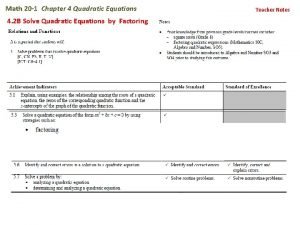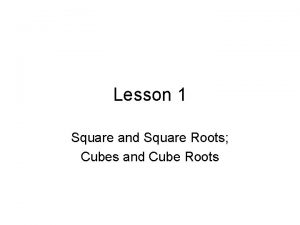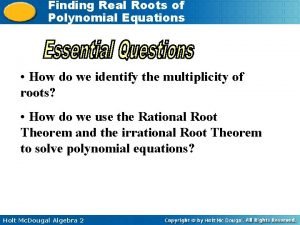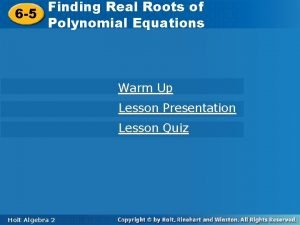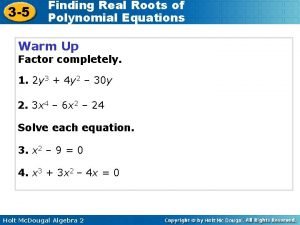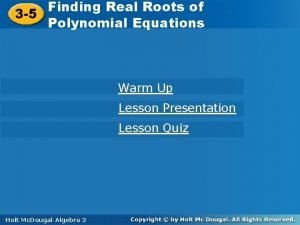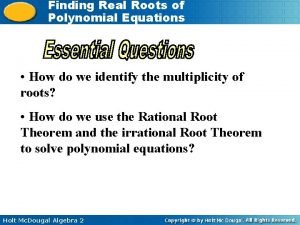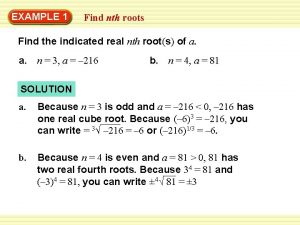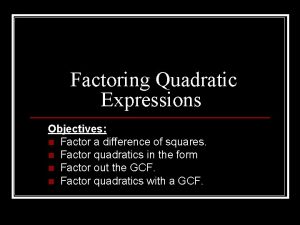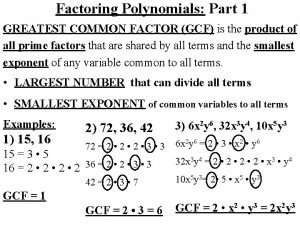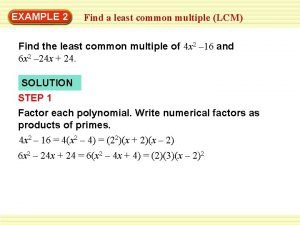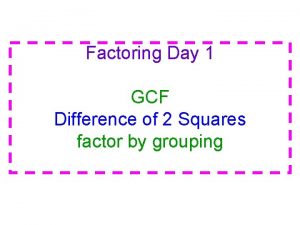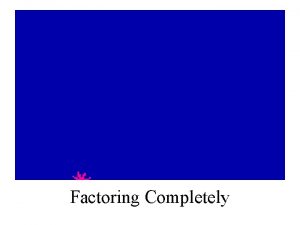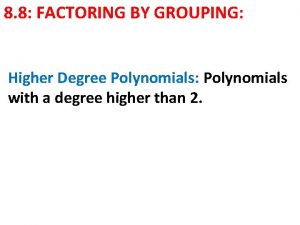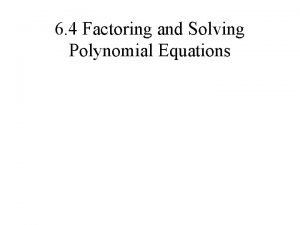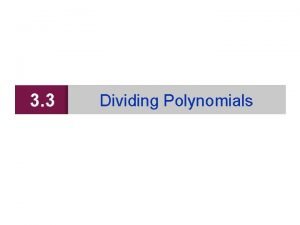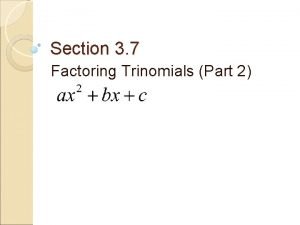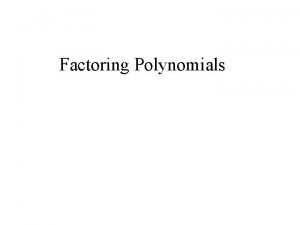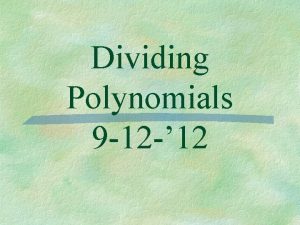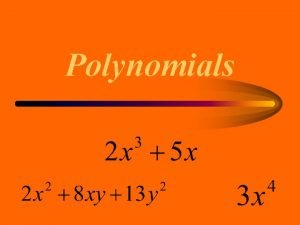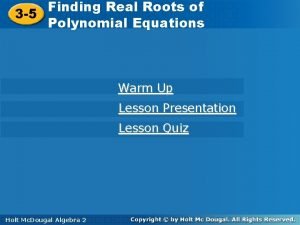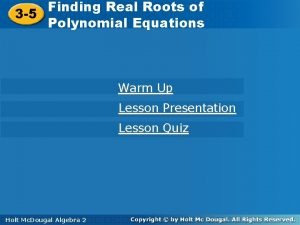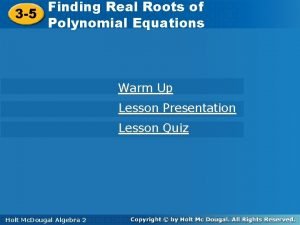Factoring and Finding Roots of Polynomials Polynomials A










































- Slides: 42

Factoring and Finding Roots of Polynomials

Polynomials A Polynomial Expression can be a monomial or a sum of monomials. The Polynomial Expressions that we are discussing today are in terms of one variable. In a Polynomial Equation, two polynomials are set equal to each other.

Factoring Polynomials Terms are Factors of a Polynomial if, when they are multiplied, they equal that polynomial: n (x - 3) and (x + 5) are Factors of the polynomial

Since Factors are a Product. . . …and the only way a product can equal zero is if one or more of the factors are zero… …then the only way the polynomial can equal zero is if one or more of the factors are zero.

Solving a Polynomial Equation Rearrange the terms to have zero on one side: Factor: Set each factor equal to zero and solve: The only way that x 2 +2 x - 15 can = 0 is if x = -5 or x = 3

Solutions/Roots a Polynomial Setting the Factors of a Polynomial Expression equal to zero gives the Solutions to the Equation when the polynomial expression equals zero. Another name for the Solutions of a Polynomial is the Roots of a Polynomial !

Zeros of a Polynomial Function A Polynomial Function is usually written in function notation or in terms of x and y. The Zeros of a Polynomial Function are the solutions to the equation you get when you set the polynomial equal to zero.

Zeros of a Polynomial Function The Zeros of a Polynomial Function ARE the Solutions to the Polynomial Equation when the polynomial equals zero.

Graph of a Polynomial Function Here is the graph of our polynomial function: The Zeros of the Polynomial are the values of x when the polynomial equals zero. In other words, the Zeros are the x-values where y equals zero.

x-Intercepts of a Polynomial The points where y = 0 are called the x-intercepts of the graph. The x-intercepts for our graph are the points. . . (-5, 0) and (3, 0)

x-Intercepts of a Polynomial When the Factors of a Polynomial Expression are set equal to zero, we get the Solutions or Roots of the Polynomial Equation. The Solutions/Roots of the Polynomial Equation are the x-coordinates for the -Intercepts of the Polynomial Graph! x

Factors, Roots, Zeros For our Polynomial Function: The Factors are: (x + 5) & (x - 3) The Roots/Solutions are: The Zeros are at: x = -5 and 3 (-5, 0) and (3, 0)

Factoring a polynomial means expressing it as a product of other polynomials.

Factoring Method #1 Factoring polynomials with a common monomial factor (using GCF). **Always look for a GCF before using any other factoring method.

Steps 1. Find the greatest common factor (GCF). 2. Divide the polynomial by the GCF. The quotient is the other factor. 3. Express the polynomial as the product of the quotient and the GCF.

Step 1: Step 2: Divide by GCF

The answer should look like this:

Factor these on your own looking for a GCF.

Factoring Method #2 Factoring polynomials that are a difference of squares.

A “Difference of Squares” is a binomial (*2 terms only*) and it factors like this:

To factor, express each term as a square of a monomial then apply the rule. . .

Here is another example:

Try these on your own:

Factoring Method #3 Factoring a trinomial in the form:

Factoring a trinomial: 1. Write two sets of parenthesis, ( )( ). These will be the factors of the trinomial. 2. Product of first terms of both binomials must equal first term of the trinomial.

Factoring a trinomial: 3. The product of last terms of both binomials must equal last term of the trinomial (c). 4. Think of the FOIL method of multiplying binomials, the sum of the outer and the inner products must equal the middle term (bx).

x x -2 Factors of +8: 2&4 -4 1&8 O + I = bx ? 1 x + 8 x = 9 x 2 x + 4 x = 6 x -1 & -8 -1 x - 8 x = -9 x -2 & -4 -2 x - 4 x = -6 x

Check your answer by using FOIL F O I L

Lets do another example: Don’t Forget Method #1. Always check for GCF before you do anything else. Find a GCF Factor trinomial

When a>1 and c<1, there may be more combinations to try! Step 1:

Step 2: Order can make a difference!

Step 3: Place the factors inside the parenthesis until O + I = bx. Try: F O I O + I = 30 x - x = 29 x L This doesn’t work!!

Switch the order of the second terms and try again. F O I L O + I = -6 x + 5 x = -x This doesn’t work!!

Try another combination: Switch to 3 x and 2 x F O I L O+I = 15 x - 2 x = 13 x IT WORKS!!

Factoring Technique #4 THE QUADRATIC FORMULA

Solve using the quadratic formula.

Factoring Technique #5 Factoring By Grouping for polynomials with 4 or more terms

Factoring By Grouping 1. Group the first set of terms and last set of terms with parentheses. 2. Factor out the GCF from each group so that both sets of parentheses contain the same factors. 3. Factor out the GCF again (the GCF is the factor from step 2).

Example 1: Step 1: Group Step 2: Factor out GCF from each group Step 3: Factor out GCF again

Example 2:

Try these on your own:

Answers:
 Lesson 3 existence and uniqueness
Lesson 3 existence and uniqueness Estimating square roots guided notes
Estimating square roots guided notes Quadratic equation roots
Quadratic equation roots List of cube numbers
List of cube numbers How to solve a polynomial equation
How to solve a polynomial equation 6-5 finding real roots of polynomial equations
6-5 finding real roots of polynomial equations Finding the real roots of polynomial equations
Finding the real roots of polynomial equations 6-5 finding real roots of polynomial equations
6-5 finding real roots of polynomial equations Finding roots
Finding roots Finding real roots of polynomial equations
Finding real roots of polynomial equations Find the indicated real nth roots of a calculator
Find the indicated real nth roots of a calculator Vanessa jason biology roots www.biology-roots.com
Vanessa jason biology roots www.biology-roots.com The roots of american imperialism 1. economic roots
The roots of american imperialism 1. economic roots Factoring steps
Factoring steps Solving quadratic equations
Solving quadratic equations Factoring polynomials gcf and quadratic expressions
Factoring polynomials gcf and quadratic expressions Factoring 1 factoring out the gcf
Factoring 1 factoring out the gcf Lcm examples
Lcm examples Factoring polynomials tic tac toe
Factoring polynomials tic tac toe Polynomials real world examples
Polynomials real world examples Long division and synthetic division
Long division and synthetic division Ac method
Ac method Factoring polynomials flowchart
Factoring polynomials flowchart Difference of 2 squares
Difference of 2 squares Factoring tool
Factoring tool Factor higher degree polynomials
Factor higher degree polynomials Factoring cases
Factoring cases Gcf warm up
Gcf warm up Formula to factor polynomials
Formula to factor polynomials Factoring polynomials using synthetic division
Factoring polynomials using synthetic division Algebra 2 unit 5 polynomial functions
Algebra 2 unit 5 polynomial functions Cross method factoring
Cross method factoring Factoring techniques
Factoring techniques Factor trinomial by grouping
Factor trinomial by grouping Diamond method factoring trinomials
Diamond method factoring trinomials Factoring polynomials jeopardy
Factoring polynomials jeopardy Factoring polynomials jeopardy
Factoring polynomials jeopardy Factoring special products part 2
Factoring special products part 2 Site:slidetodoc.com
Site:slidetodoc.com 3-4 factoring polynomials
3-4 factoring polynomials 7-4 factoring polynomials
7-4 factoring polynomials Recall the different methods of factoring polynomials
Recall the different methods of factoring polynomials A perfect square trinomial
A perfect square trinomial


